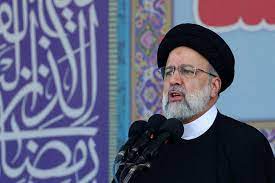DUBAI (AP): A series of websites linked to Iran’s presidency bore the images of two leaders of an exiled opposition group Monday, with others showing the pictures of Islamic Republic’s supreme leader and president crossed out.
An internet account describing itself as a group of hackers claimed responsibility for allegedly taking down websites. The account GhyamSarnegouni, whose name in Farsi means “Rise to Overthrow,” previously claimed hacking websites associated with Iran’s Foreign Ministry earlier this month.
Iranian state media and officials did not immediately acknowledge the apparent hack. However, Associated Press journalists accessing the sites found them defaced with images of Massoud Rajavi, the long-missing leader of the Iranian exile group Mujahedeen-e-Khalq, and his wife Maryam, who is now the public face of the group.
One site bore the slogan: “Death to Khamenei Raisi- Hail to Rajavi.” Iran’s Supreme Leader Ayatollah Ali Khamenei and Iran’s president Ebrahim Raisi both were targeted similarly in the previously claimed hacked in May.
Iran has been targeted by a series of embarrassing hacks amid the rising tensions over its rapidly advancing nuclear program. That’s included the signal of Iranian state television being targeted, gasoline pumps that provide subsidized fuel being targeted in a cyberattack and government surveillance camera imagery being released, including from a notorious prison.
The Mujahedeen-e-Khalq, known by the acronym MEK, did not immediately respond to a request for comment. The MEK had angrily condemned a prisoner swap Belgium conducted with Iran on Friday to free an aid worker that saw an Iranian diplomat convicted of being behind a bomb plot targeting the group released.
The MEK began as a Marxist group opposing the rule of Shah Mohammad Reza Pahlavi. It claimed and was suspected in a series of attacks against U.S. officials in Iran in the 1970s, something the group now denies.
It supported the 1979 Islamic Revolution, but soon had a falling out with Ayatollah Ruhollah Khomeini and turned against the cleric. It carried out a series of assassinations and bombings targeting the young Islamic Republic.
The MEK later fled into Iraq and backed dictator Saddam Hussein during his bloody eight-year war against Iran in the 1980s. That saw many oppose the group in Iran. Although largely based in Albania, the group claims to operate a network inside Iran.







